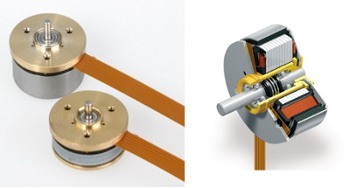 |
| August 21, 2012 | Volume 08 Issue 31 |
Designfax weekly eMagazine
Archives
Partners
Manufacturing Center
Product Spotlight
Modern Applications News
Metalworking Ideas For
Today's Job Shops
Tooling and Production
Strategies for large
metalworking plants
Engineer's Toolbox:
15 pancake motors move humanoid robotic hand

The DLR-HIT Hand II, developed by the German Aerospace Centre, features three EC 20 flat drives (pancake motors) from maxon motor fitted into each of the fingers.
The human hand is undoubtedly one of the most universal and complex tools of nature. The German Aerospace Centre (DRL) has developed a robotic hand in conjunction with the Harbin Institute of Technology (HIT). Compared with its predecessor, the DRL-HIT-Hand I, the new DLR-HIT Hand II has five fingers, each with four joints and three degrees of freedom, and is smaller and lighter. Four fingers are required for clasping conical parts, and a thumb is used as an outer support. The mechanical range of movement must be properly controlled and monitored to enable the hand to be used fully.
The motors in the DRL-HIT Hand II are fitted directly into the fingers. This means that particular attention has to be paid to the control processor's information with positioning and operating data. This is the only way that the discrete drive can show all its strengths in situ. Every finger joint is therefore fitted with a self-developed, non-contacting angle sensor and a torque sensor. Due to the application, both sensors must resolve very highly. A high-speed bus transmits the data flow. Rapid feedback for comparing target and actual value is crucial for the function of the controller, particularly in precise and delicate applications. Therefore, aside from the data volume, speed of transfer is also vital.

EC flat motor(left) and motor cutaway from maxon motor.
Flat motors as drives
Each finger needs several drives that can all be controlled separately. In this instance, 15 maxon brushless DC motors with Hall sensors are used for each hand.
maxon motor's EC 20 flat drives meet several key requirements, in that they are inexpensive, commercially available products with a high power density in a compact design. The motors, including Hall sensors, create a unit that is only 10.4-mm long with an outer diameter of 21.2 mm. Each motor weighs 15 g. They are mounted with harmonic drive gears from the HDUC 05 range, which have the same diameter. The 3-W motors are available in a 12- or 24-V version and provide maximum torque of 8.04 mNm. Good dynamic behavior and preloaded ball bearings ensure precise response behavior of control commands, including changing the direction of rotation. The digital Hall sensors always report the actual position to the controller accurately. The motors idle at 9,300 rpm.
Thanks to compact drive technology with feedback and rapid data transfer using bus technology, the DLR-HIT Hand II can be controlled very sensitively and precisely. In this instance, micromechanics and microelectronics complement each other perfectly, and this next-generation robotic hand proves that standard components can be used to produce well-designed products that would have been previously unimaginable, even with expensive, custom components.
Source: maxon motor
Published August 2012
Rate this article
View our terms of use and privacy policy
